A lot GMAT aspirants targeting a V40+ on the GMAT have no idea as to how to improve their GMAT Verbal Score! GMAT Verbal is a refuge for people who are not strong in Quant. Most people believe that to ace the GMAT you have to be really good at Math. Ask Anupriya and she’ll refute this statement. She scored a 760 (99 percentile) on the GMAT with a Q48 (67 percentile) and a V46 (99 percentile). She even received an admit from the Indian School of Business. What makes the GMAT Verbal even more lucrative is the sheer scope of scoring in this section. Therefore, scoring high on GMAT verbal can be a gateway to scoring 760+ on the GMAT. But how can you score high on GMAT verbal?
1. Introduction – How to score high on GMAT Verbal
Tired of learning Verbal concepts and still struggling to improve your GMAT Verbal score? Not sure where you are faltering? If the answer is yes, then irrespective of whether you are currently below V30 like Kartik, who improved from V27 to V41, or are around V36 like Pratique, who improved from V34 to V47, we are here to help you!
Most of the students preparing for GMAT Verbal get stuck in the concepts and fail to realize that GMAT Verbal is a test of logic and not just our ability to learn concepts! No- we are not saying this. The GMAC says this.
As per the GMAC, “GMAT Verbal section measures the test taker’s ability to read and comprehend written materials, reason and evaluate arguments, and correct written material to conform to standard written English.”
Hence, GMAT Verbal is much more than just a language test. Approximately 2300 graduate business schools worldwide that accept GMAT scores. But they are not actively seeking out grammarians for their graduate management programs. Rather they need people who can think logically and communicate effectively.
Hence, the conceptual knowledge of ‘what a modifier is’ or ‘what an assumption is’ may not be enough to solve questions and score well in GMAT Verbal. You need something more. What is this “something”? It is a tested strategy that can help you work on all the aspects tested in GMAT Verbal. Irrespective of whether you studied in a convent school or whether English was your tertiary language, this strategy can help you score well in Verbal. Also, the equally important inference is that anyone can get a high score in Verbal if they follow the right approach.
When should you take the GMAT?
When it comes to selecting the right test date for your GMAT, the verbal section plays a crucial role. The GMAT verbal section tests various skills which require time and practice to master. It’s important to choose a test date that allows you enough time to thoroughly review and practice these verbal concepts. To help you with this, we’ve created a quiz that will provide you with personalized recommendations on the best test date for you. Our quiz takes into account your current level of preparation and your target score to suggest the most suitable test date for you. So, take a few minutes to complete the quiz and gain valuable insights that will help you achieve success on the GMAT!
This article will help with the same by discussing:
- How to score high on GMAT Verbal?
- How to improve GMAT Verbal score in a predictable manner?
- What metrics to track to score a V41 in GMAT Verbal?
- How to overcome the V36 plateau?
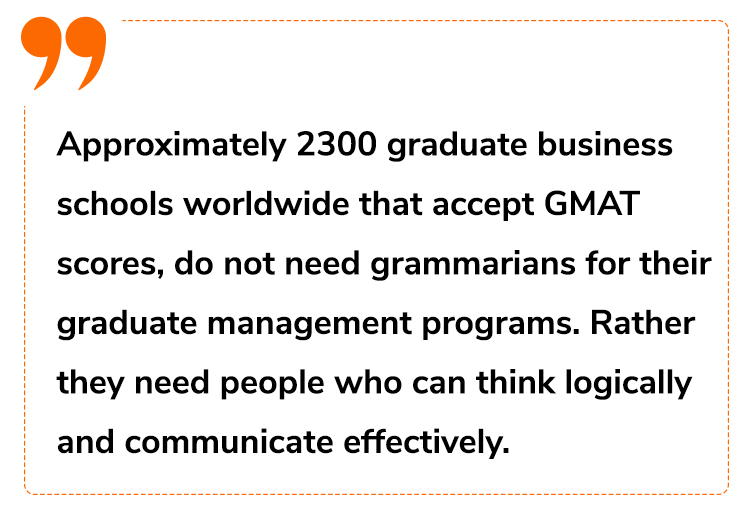
2. What does V40 mean?
V40 translates to the 90th percentile as per the latest definition by GMAC. In simple words, a score of V40 means that you performed better than 90% of the test takers. Clearly -it is a very high score. It is representative of the fact that you can solve medium and hard questions with extremely high precision in SC, CR, and RC.
However, why is that important? It is important since it indicates that you can communicate well- you do not tend to misunderstand or ignore the given information, you tend to think logically and reason out, and you can express your thoughts clearly. This score demonstrates your likelihood of succeeding in graduate-level management studies and hence increases your chances of getting an admit.
Some of you may find it surprising, but Q50 also represents the same level in terms of skills tested in the Quant section. Essentially, V40 is not the same as Q40. Please go through this article to understand how to get to Q51.
Coming back to Verbal, now that you know what V40 means, let us understand what it is composed of.
2.1 What are the various sub-sections in Verbal?
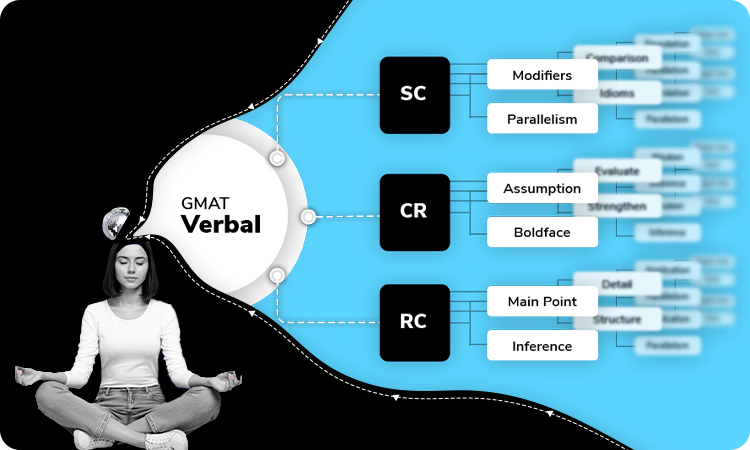
As can be seen in the above image, the Verbal section is composed of three sub-sections- Sentence Correction (SC), Critical Reasoning (CR), and Reading Comprehension (RC). You may be surprised to see how each sub-section contributes towards the goal behind GMAT Verbal section.
- Sentence Correction– This section tests your ability to identify sentences that are grammatically and structurally correct and clearly express a logical meaning. This is the one section where you need to have a basic understanding of English grammar because this understanding will affect your decision to select/reject some choices. However, some students have a misconception that just good grammar is sufficient to get good SC ability. We call it a misconception since a significant proportion of SC questions test you on the understanding of what the author is trying to convey, i.e., the intended logical meaning of the sentence.
If you too had this misconception, try solving this Hard question from Official Advanced. Make sure to go through the solution to see how understanding the logic can help you solve hard SC questions easily.
Also, do go through this article for details regarding how to approach GMAT SC.
- Critical Reasoning- Moving a step further, this section tests your ability to understand, reason out and evaluate arguments. Just imagine yourself in a managerial position where you need to approve a proposal- you will have to understand the proposal, its assumptions, the conditions under which it will work, and the conditions under which it will fail. You may also have to ask for additional information before you approve it. Imagine the level of understanding and reasoning that will go into this whole process. CR questions test you on the same. You are expected to conduct this analysis on a passage that typically has 100 or fewer words.
Try solving this Hard Assumption question from Official Advanced. Make sure to go through the solution to understand what you are expected to do in CR questions.
Do go through this article for details regarding how to approach GMAT CR.
3. Reading Comprehension- This section is feared by many just because of the length of RC passages. In the hierarchy, it is the next step that tests you on your ability to comprehend a 200 to 350 words passage. You are expected to understand the intent behind different components of the passage and their roles, understand the relationship between these components and draw inferences from the information given.
Try solving this Hard RC Official passage. Make sure to go through the solution here to understand what you are expected to do in RC questions.
Do go through this article for details regarding how to approach GMAT RC.
So, together these three sections test your ability to read and comprehend information, understand, reason out and evaluate arguments, and communicate your point of view effectively.
Let us now understand the role that these sub-sections play in your Verbal score. In case you have questions like “I am good with SC and CR but weak in RC, can I score well in Verbal?”, you will get your answer here.
2.2 Excellence in three sub-sections
Your Verbal score (out of 60) is composed of your scores in SC, CR, and RC. Hence, in order to get to a particular score, you can target different combinations. For example, this screenshot from an ESR shows a combination of percentiles for getting V28.
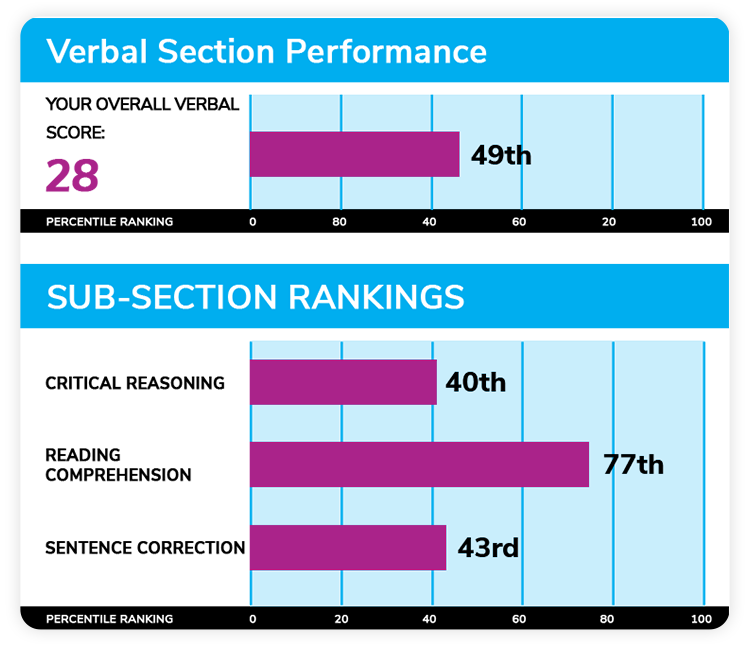
You can get a similar score with this combination:
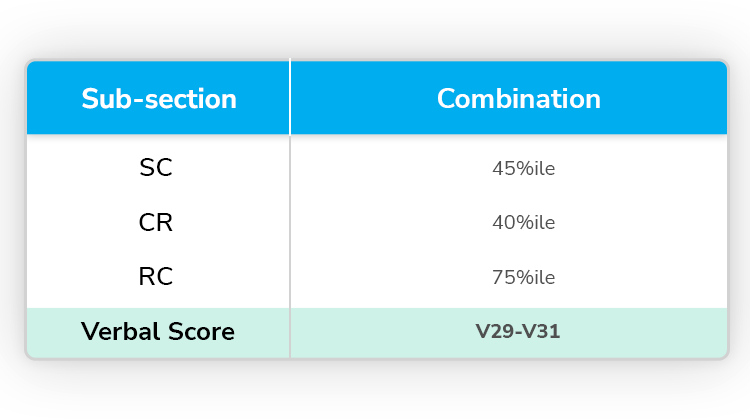
Now, in order to get to V40+, you can target various combinations:
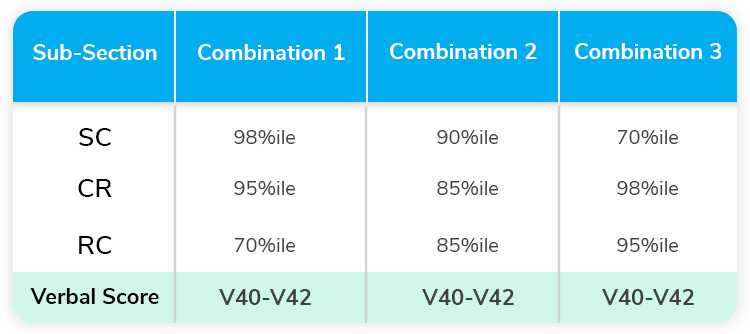
Hence, depending on your comfort level with various sub-sections, you can either target high percentile in 2 sections, as done in Combination 1 and 3, or set similar targets in each sub-section as done in Combination 2- GMAT gives you that flexibility.
Another important thing to note here is that since you want to perform better than at least 90% of the test takers, your target score even in your weaker section cannot be very low. In short, in order to score V40+, you need to excel in all three sub-sections.
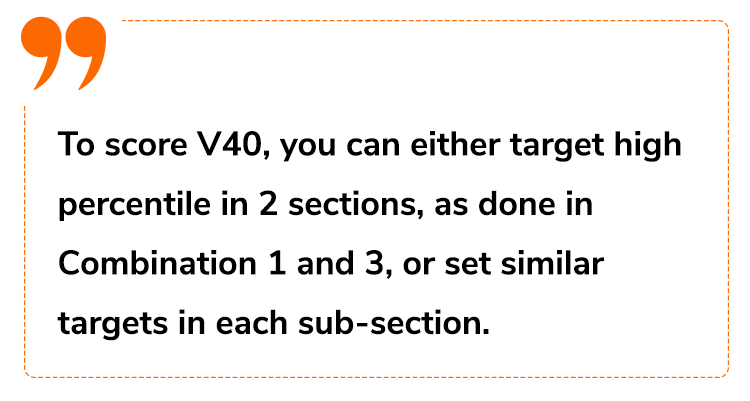
PS- The score in each sub-section is independent of the score in other sections. For example, the difficulty level of CR questions being served will not depend on your performance in SC. So even if a student performs poorly in one sub-section, he can score well in the other.
3. What gives us credibility?
Well, it is the success that we deliver. e-GMAT- the most reviewed company on GMAT Club, the company with the maximum number of V40+ verified reported scores, the company with the maximum number of 700+ verified reported scores, and the company with the maximum number of 5-star reviews on GMAT Club- has been known for its Verbal offering for more than 10 years. We are the pioneers of the Meaning Based Approach for solving SC questions, which by the way is the only tried and tested approach for solving SC questions with consistently high accuracy. We developed and simplified the visualization and prethinking approach for CR questions. We are the ones who make you fall in love with RC with our simple reading strategies. We do not teach shortcuts to solve questions; we help you develop skills that are useful during and beyond your MBA.
The success that we deliver speaks for itself. Do go through the Reviews on GMAT Club. The 2400+ verified reviews are all posted by our students, and you will find a different story yet similar experience in all these reviews. It is so because our courses and strategies have been designed considering what the GMAT tests and work for every diligent student, irrespective of their starting ability and educational background.
Here is what some of our students have to say:
“The pre-thinking approach taught in CR is section is undoubtedly the best and most sought-after approach in answering the CR questions. “- hsoni66
“The course will not just help in GMAT (the prime focus of the course), but it should also help with written English – right from comprehension to developing a knack for writing unambiguous text. “- sumanyug
“This systematic approach, if followed diligently, cuts down the time “significantly”. And that’s why I got a V42 in the actual exam. “ PyjamaScientist
4. How to improve to V40+
Now that we understand the relevance of V40 and the fact that anyone can get a high verbal score by following the right approach, let’s get into the most crucial part – What is this right approach to get to V40+?
4.1 Step 0- Get the right starting point
The first and one of the most crucial steps in your preparation is to understand your starting point, i.e., if you write GMAT today, how would you perform in various sub-sections. Statements/ opinions such as “I am weak in Verbal”, and “My SC is not strong” will not help. You would need an approximate estimate of your starting abilities in SC, CR, and RC- taken from a mixed adaptive GMAT-like test, if not from GMAT.
You may have two questions-
- Why do you need to know your starting ability in that level of detail?
- How can you get these starting abilities?
I have very simple answers to these questions:
4.1.1 Why Should You Know Your Starting Ability?
Let me take an example to explain the same. Let’s consider there are two students- A and B. Both are at V34 and want to get to V40+. What would you suggest they do?
Most likely, the suggestion would be to prepare/ revise for all three sub-sections- spend equal time on all three. Well, that is the best that can be done. However, it may take them significantly more time to cover all three sub-sections. As a working professional or a full-time student preparing for GMAT, would you prefer an option that requires more time?
Let’s now bring in the starting abilities for A and B:
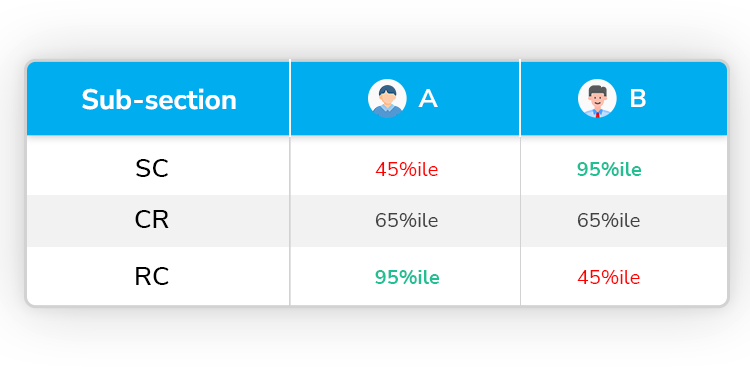
Clearly, A is weak in SC and strong in RC, while B is weak in RC and strong in SC. As discussed above, to get to V40+, they need to excel in all sub-sections. So, depending on their comfort levels,
- A can either perfect SC and maintain CR and RC or improve both SC and CR and maintain RC.
- B can either perfect RC and maintain SC and CR or improve both CR and RC and maintain SC.
Imagine the amount of time that will be saved and the clarity that A and B will have in terms of their preparation strategy now.
Hence, you need to know your starting abilities in order to:
- Understand the challenge in front of you.
- Get good time estimates.
- Start at the right stage of preparation.
In simple words, different students can have different starting points and will therefore travel different journeys but will arrive at the same destination- a V40+ score. The better you can define this journey, the easier it will be for you to get to your target score.
I am sure you will now be able to convince anyone to start their GMAT preparation only with a good understanding of their starting abilities!
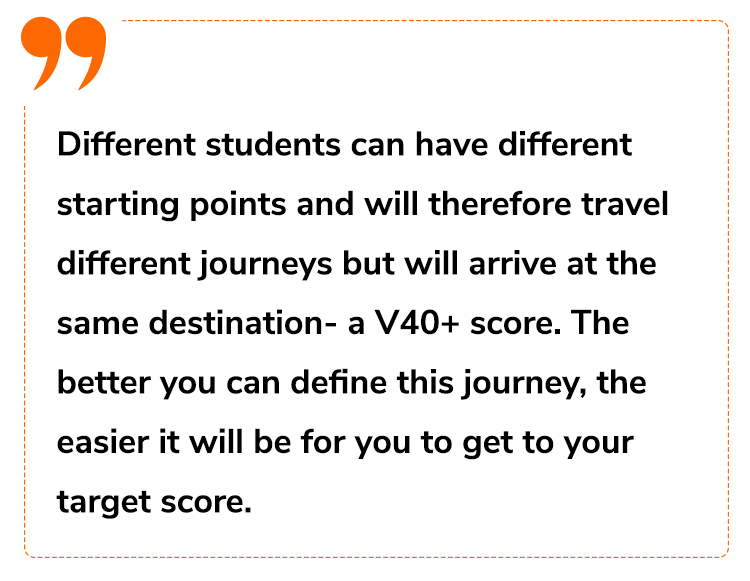
4.1.2 How can you get these starting abilities?
The answer is simple. You have only two reliable sources for your starting abilities:
- ESR report from the actual attempt:
If you have taken GMAT recently and have the ESR report, you can get your starting abilities from the same. Consider the screenshot for reference:
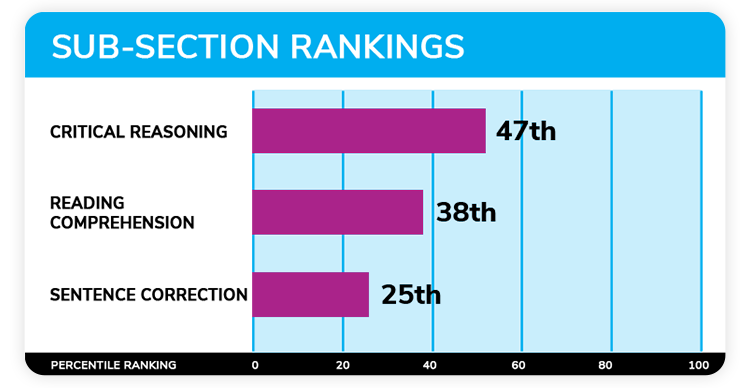
Clearly, this student needs to focus on all three sub-sections.
- SIGma-X Mock attempt:
I am sure you would know that the Official mocks and SIGma-X mocks offered by e-GMAT are the two most reliable mocks in GMAT space at the moment. The SIGma-X mocks are adaptive, test you on a specific combination of questions, and are based on an algorithm that predicts your abilities with a high level of accuracy. Additionally, the insights that SIGma-X mocks provide are not available even with an Official mock.
Here are some of the insights that you can get from a SIGma-X mock:
- Reliable Sectional Scores:
- Sub-sectional Abilities- The world’s only mock test that gives ability scores for SC, CR, and RC.
- Progression in Verbal and in each sub-section: To give an idea of the difficulty level of questions you are faltering in and how well you utilized your time.
- Topic-wise feedback for each sub-section
Clearly, this data will help you evaluate your current position and plan effectively. This is how we, at e-GMAT, access the starting abilities of all our students and provide them with personalized plans.
Click on these links to see what a few of our students – Akshat, Ayush, and Abhilash have to say about the SIGma-X mocks.
Want to try it out? Feel free to take the first SIGma-X mock for free to understand your current abilities.
Also, in case you are planning to buy a course that claims to provide you with a personalized plan, make sure to understand how your current abilities will be assessed to create the personalized plan. I am sure, with all this understanding, you will not let anyone misguide you by saying that a non-adaptive test or maybe a 10-15 question quiz can be used to assess your sub-sectional abilities correctly.
4.2 Step 1- Master One Topic at a Time
While preparation strategies can make your journey to your target score more effective, one of the key components of your journey is to master the concepts tested in GMAT, and your success is very much dependent on how well you master these concepts. Now, mastering the concepts includes two steps-
4.2.1 Identify the correct list of concepts tested on the GMAT-
Your time is precious. Hence, whatever time you invest in GMAT preparation should be spent on the topics that are actually tested on the GMAT. I don’t want you to study something that is not even tested. Similarly, I don’t want you to miss anything that is tested. Hence, you need to confirm the list of topics from a reliable source.
- Official Guides are one of the main sources of this information. You can go to the description of each section to understand what is tested in that section. Here is a screenshot from SC section in OG 22:
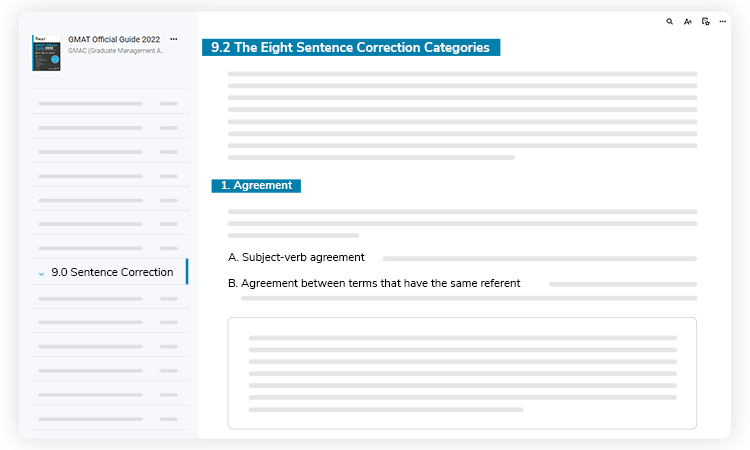
- If the description in OG confuses you, you can refer to this module structure offered as a part of the e-GMAT course to understand where you should focus your energy. You can also refer to our detailed articles on SC, CR, and RC for these details.
4.2.2 Understand these topics and their application
This is the step where your actual study begins. The knowledge that you gain here will be the foundation for your GMAT preparation. For a good score, it is very important to lay a solid foundation. So, how should you go about it?
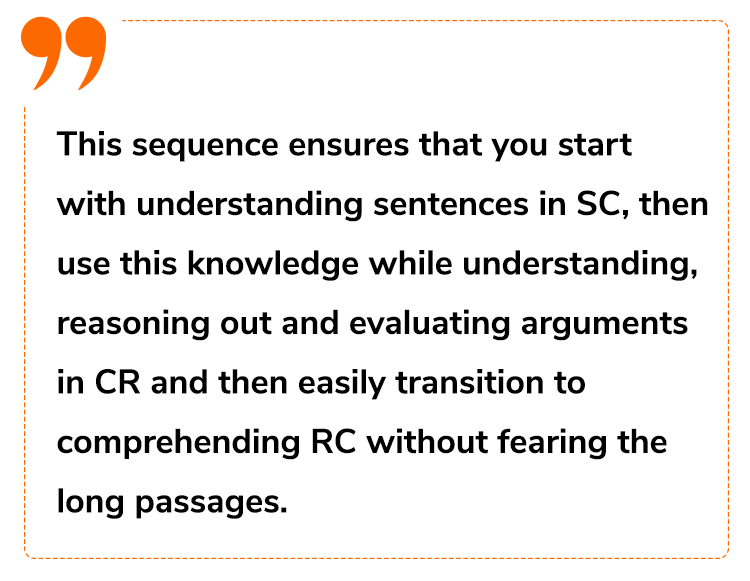
Start with one sub-section. I would suggest that you start with SC, then move on to CR, and then RC. This sequence ensures that you start with understanding sentences in SC, then use this knowledge while understanding, reasoning out, and evaluating arguments in CR, and then easily transition to comprehending RC without fearing the long passages. However, the sequence can be modified to suit your comfort.
Within each sub-section, it is very important that you master every topic. Let me take SC as an example to explain the same.
Within SC, you have multiple topics, for example, Subject-Verb, Pronouns, and Verbs. So, when you start with SC, pick one topic- let’s say you pick Subject-Verb. The goal here is to:
- Fix all the concept gaps- So, by the time you finish this step, you should know:
- What is a subject and a verb?
- How many subject-verb pairs can a sentence have?
- What are the characteristics of a correct subject-verb pair?
- Learn the right way to apply those concepts – As you know, GMAT does not expect you to explain what the Subject-Verb concept is but to apply it on questions. So, by the time you finish this step, you should know:
- How can you identify subject-verb pairs in a sentence?
- How can you check if the subject-verb pair meets all the requirements of a correct subject-verb pair?
- Ensure that you can apply this concept to a certain degree- So, this is a litmus test for what you have learned in steps 1 and 2. After the first two steps, you should be able to identify and correct Subject-Verb errors in Easy and Easy-Medium level questions. If you cannot do that, you have not mastered the concept yet.
In case you were working on this topic, do try to identify if these two Easy Official Questions have any error related to the Subject-Verb pair:
The three steps discussed above need to be repeated for every concept in SC, i.e., for Pronouns, Verbs, Modifiers, Parallelism, Comparison, Idioms, and Meaning.
Similarly, when you are working on CR, you need to do the same for Inference, Assumptions, Evaluate, Strengthen, Weaken, Boldface, Paradox, Flaw, etc.
In RC, you need to do the same for Main Point, Inference, Detail, and Function.
4.2.2.1 Resources – Books Vs. e-GMAT
Here is how you can master the concepts if you are preparing using books:
- You will find that most of the GMAT prep books teach concepts well. They may sometimes go beyond the GMAT scope, but at least you will not miss any concept.
- When it comes to evaluating how well you have learned the concepts, books do not offer a lot of options. For example, after studying that a subject and a verb should agree in number, how will you ensure that you have understood this concept? It is still too early to go to OG questions, and books might not provide you assessments to assess your understanding at this level. My suggestion- try applying this skill on some sentences from articles taken from Economic Times, Wall Street Journal, etc.
- To evaluate how well you can apply the concept, you will have to search for questions of the right difficulty level and that test the concept that you have studied. It is a time consuming task but will pay off well.
- You should keep track of all stats to ensure that you have mastered the specific concept.
At e-GMAT, we have structured all the content into various modules. The modules consist of various kinds of files that ensure you master the topic before moving ahead to the next module.
Below is a screenshot of the Subject Verb module in the e-GMAT course.
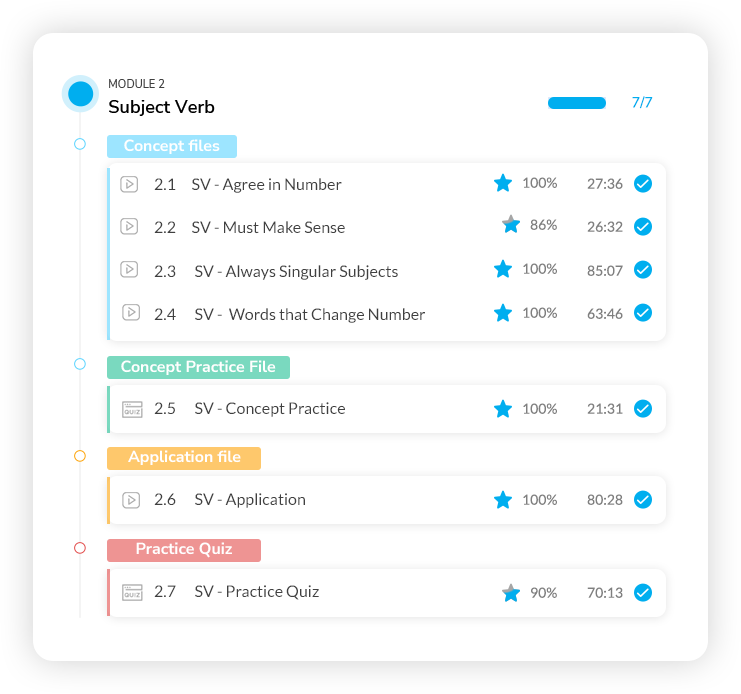
- Files 2.1- 2.4 are Concept files, each teaching a different concept related to Subject Verb. Each of these files has assessment quizzes to evaluate your understanding of the concept. Here is an example of the xPERT AI-driven feedback that you get at Concept Level.
- File 2.5 is a Concept Practice File, a file that tests your understanding of all concepts taught in previous files.
- File 2.6 is an Application file that teaches you how to apply the 3-step process to find Subject -Verb related errors on GMAT-like questions. Here is an example of the xPERT AI-driven feedback that you get at the Application Level.
- File 2.7 is a Practice Quiz that is the final test of your understanding of the concepts as well as process taught in this module.
Our platform keeps track of all the student stats and also provides feedback at required points. In short, an e-GMAT student just needs to worry about studying diligently. The rest of the things are taken care of by the e-GMAT platform.
To summarize, irrespective of whether you are an e-GMAT student or not, you should follow the suggested steps and master each topic one by one before moving ahead. If, as per your starting ability, you are already comfortable with all topics, you can start with the next step.
4.3 Step 2- Cement your understanding
I always tell my students that Step 1- Mastering the concepts is like constructing a wall- laying bricks and applying cement between them. Every topic increases the height of this wall. Although the steps taken to master the topics ensure that the wall is really strong, the question is whether you can leave such a high wall just like that- without cementing the entire surface. Clearly, if you do so, the wall will not stay solid for long.
Step 2- Cementing-does the same reinforcement at the sub-section level. So, after you have mastered all the topics in, let’s say, SC, your goal should be to meet these metrics:
- Medium Difficulty questions – at least 80% accuracy in a timed environment.
- Hard Difficulty questions – at least 60% accuracy in a timed environment.
This step ensures a smooth transition from solving questions from one topic at a time to questions from multiple topics at the same time and also introduces you to the world of timed quizzes. Yes, timing is a big concern for most of the students, and this is the right time to start thinking about timing. If you start timing yourself before this stage, you may take away your focus from mastering concepts. Also, unless you are really confident with the topics, you will not be able to effectively work on reducing your time to solve questions. Hence, Step 2 is the ideal time to start considering the timing aspect.
At e-GMAT, we ask you to attempt pre-designed Medium level Cementing quizzes- quizzes having a fixed composition of questions from various topics. Once you pass the Medium quizzes, we ask you to take similar Hard Cementing quizzes. Faltering in any of the Cementing quizzes indicates that you have conceptual/ process gaps, and we provide improvement plans that help you identify and work on your weak areas. Passing this stage successfully indicates that you have cemented the wall for the sub-section perfectly, and you can confidently move to the next sub-section!
Below are screenshots taken from the account of a student who scored 770 (Q50, V47). You can watch her talking about the same in her success story interview here.
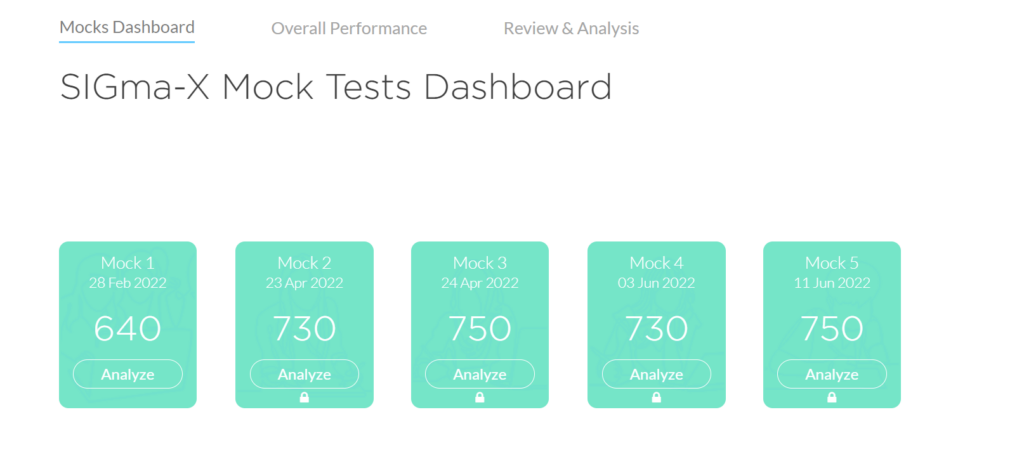
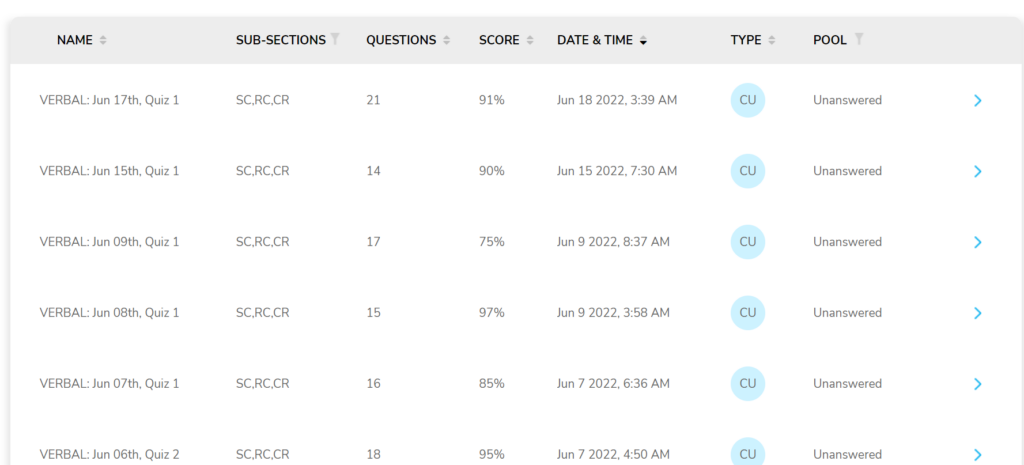
- How to Cement If You Are Studying Using Books-
You can do this using books or official questions. You just need to ensure that you hit the same metrics. Here are a few things that you need to take care of:
1. Get questions of the right difficulty level.
2. Ensure that you get questions that represent all areas within a topic.
3. Ensure that you get enough questions – solve at least 50 questions here.
4. Make sure that you hit the accuracy numbers (Medium- at least 80%, Hard – at least 60%).
5. Make sure that you have solutions that you can review to understand where you faltered.
6. Make sure that you identify your weak areas and take corrective actions to improve your performance.
4.4 Step 3- Achieve Excellence by Leveraging Analytics
This final refinement step allows you to improve from a very good score to an excellent one. There are students who have learned the concepts decently well and know how to apply these concepts, some have even cemented their understanding, but still, they find it difficult to cross the V36-V37 plateau. Why is that so?
It is so because these people have minor gaps in specific topics. If they can identify these topics and get the correct improvement plan, V40+ will not be difficult.
How to Find the Weak Areas-
Analytics comes to the rescue here. If you are an e-GMAT student, here is what you need to do:
- Go to Scholaranium Skill Data.
- For every topic, toggle the medium and hard sections to look at accuracy by areas. Take a note of the topics where accuracy is below 50%. These are your weak topics.
- Revise the incorrect questions from the weak topics- one at a time- by replaying them using Scholaranium’s custom quiz engine.
- Review the solutions. The intent is to identify where you faltered. Take a note of all conceptual/ process gaps.
- Update your error log for all these questions.
- Go back to the course and redo the Concept Practice Files, Application Files and Practice Quiz for that topic. If required, review the Concept file as well. You should be able to bridge the gaps identified in the previous step.
- After you are sure of having bridged the gaps, come back and practice questions in those areas using Scholaranium’s custom quiz engine.
- Go get a V40+ score.
Here are some of our students who crossed this plateau using the analytics provided:
- Rafealla improved from V36 to V42 by focussing on SC for 10 days.
- Abhishek improved from V34 to V40 after analysing his weak areas.
If you are studying using books, you will not have access to such analysis, but you can create a simpler version of this step by doing the following
- Review at least the last 30 incorrect questions in the sub-section.
- Update your error log for all these questions.
- Try to group your errors into a few categories so that you can work on them.
- Review the concept and try to bridge the existing gap.
5. Conclusion
We would now like to conclude by re-iterating that GMAT Verbal is not just a test of grammar but a test of logic as well. If you prepare for it using the right strategies, scoring V40+ will not be difficult, irrespective of what and how you have studied in the past. What matters is not your intelligence but
- Whether you put in focused effort.
- Whether you started at the right point.
- Whether you used the right process to build ability.
- and whether you refined to perfection.
Anyone who is methodical and who perseveres enough can do it. So, what are you waiting for?
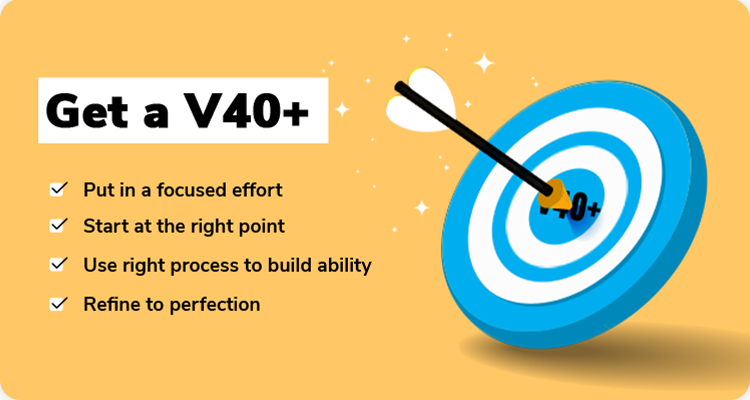
Happy learning,
Kanupriya
There are 2 things to keep in mind.
- Mastering concepts of Sentence Correction, Critical Reasoning, and Reading Comprehension
- Devising test-taking strategies to leverage the adaptive nature of the GMAT.
Before going into how to score V40+ on the GMAT, first, let’s understand what makes GMAT verbal section important.
Here is the outline of this article:
- What makes GMAT Verbal section important?
- How to improve Sentence Correction
- How to improve Critical Reasoning
- How to improve Reading Comprehension
- Test taking strategies to score V40+

What makes GMAT Verbal section important?
Your overall GMAT score is dependent on how well you do on the quant and verbal sections. You can score between 6 and 51 on both the sections. But, there is one catch. Scoring, let’s say, a 46 on both quant and verbal does not mean that you scored the same percentile in both sections. Take a look at the score and percentile chart below.
A score of 46 in verbal translates to 99 percentile whereas a 46 in quant translates to just 58 percentile.
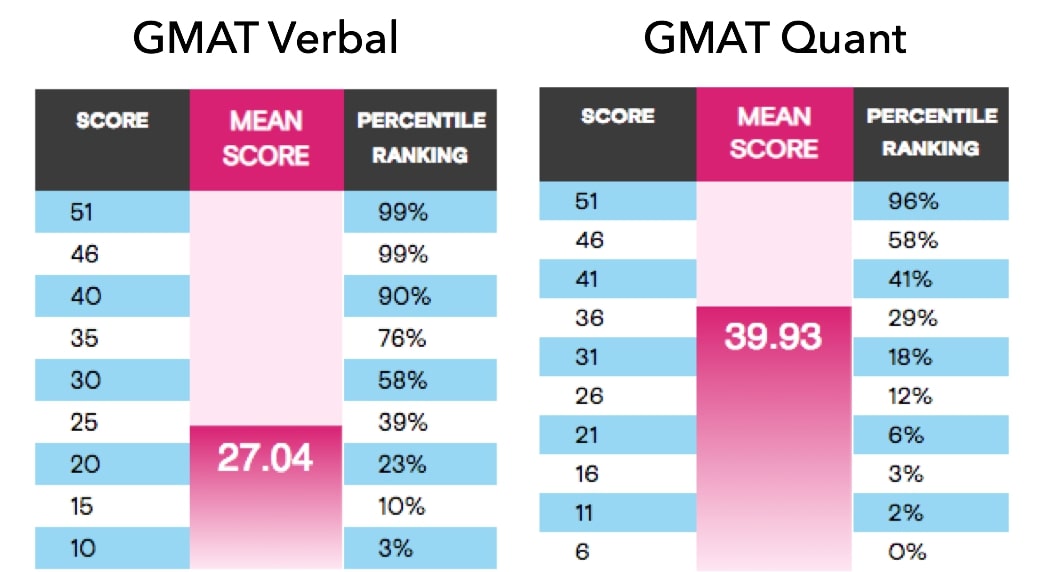
What it means is that more people score high on the Quant section than on the verbal section. The mean score for the quant section is 39.93 as compared to 27.04 for the verbal section.
Therefore, the verbal section becomes all the more important if you want to score above 740 on the GMAT which is a 97 percentile score. A (Q50, V40) or (Q49, V42) can result in a score of 740 on the GMAT.
Therefore, scoring above V40 will definitely help you score 740+ on the GMAT, provided you score at least a Q50 on the GMAT.
Let’s take a look at what V40+ scorers did to improve the 3 verbal sub-sections i.e., Sentence Correction, Critical Reasoning, and Reading Comprehension.
GMAT verbal – How to improve Sentence Correction
Sentence Correction is the one sub-section with which many GMAT takers struggle while preparing for the verbal section. Why? Because most people don’t have a basic understanding of the building blocks of a sentence. That is why they struggle to deconstruct and construct a sentence to derive its meaning.
Therefore, it is essential to learn the meaning-based approach to solve SC questions, after all, GMAT SC is more about logic and meaning than grammar and vocabulary.
Let’s take the example of SC preparation from Rohan’s story who scored a 750 with a V40.
Rohan scored a V40 on the GMAT
Rohan’s story is remarkable because he comes from a vernacular academic background. He studied in a Gujarati medium school and therefore, he was apprehensive about the verbal section. His verbal score is proof that GMAT verbal, especially the SC sub-section tests logic and meaning rather than grammar and vocabulary. Take a look at his ‘SC accuracy based on question types’ from his ESR.
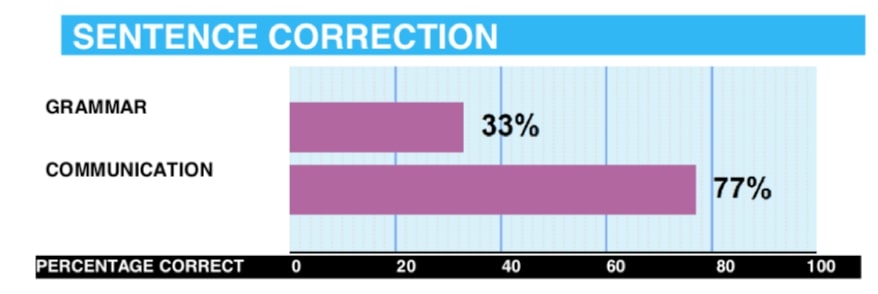
In SC, only 33% of his answers were correct on grammar questions. Still, he managed a score of V40.
So, how did he do it? He followed a simple approach to understand the meaning of a sentence in one read. Also called the meaning-based approach, this approach helps you to understand the meaning of a sentence in one read, thereby avoiding confusion caused by re-reading the answers and questions.
In his debrief, Rohan said, “I started with SC and followed the meaning-based approach and was able to identify the error in 30 seconds by spending some time with the question stem before going to the answer choices.”
So, how does one learn the meaning-based approach?
Let’s take a look at Ram’s strategy to understand the meaning-based approach.
If you are planning to take the GMAT, we can help you with a personalized study plan and give you access to quality online content to prepare. Write to us at acethegmat@e-gmat.com. We are the most reviewed GMAT prep company on gmatclub with more than 1840 reviews (as on July 5, 2019). Why don’t you take a free trial and judge it for yourself?
Ram’s SC strategy to scoring V41
Ram, before scoring a V41, made a simple but a consequential mistake. Before learning the meaning-based approach, he’d rely purely on ‘process of elimination’ approach. He would read the question and then immediately the options and would continue to re-read them until getting confused between two options and randomly marking an answer. At this point, his accuracy was 60 – 70%.
Take a look at the below infographic to understand his approach to solving SC questions before and after learning the meaning-based approach.
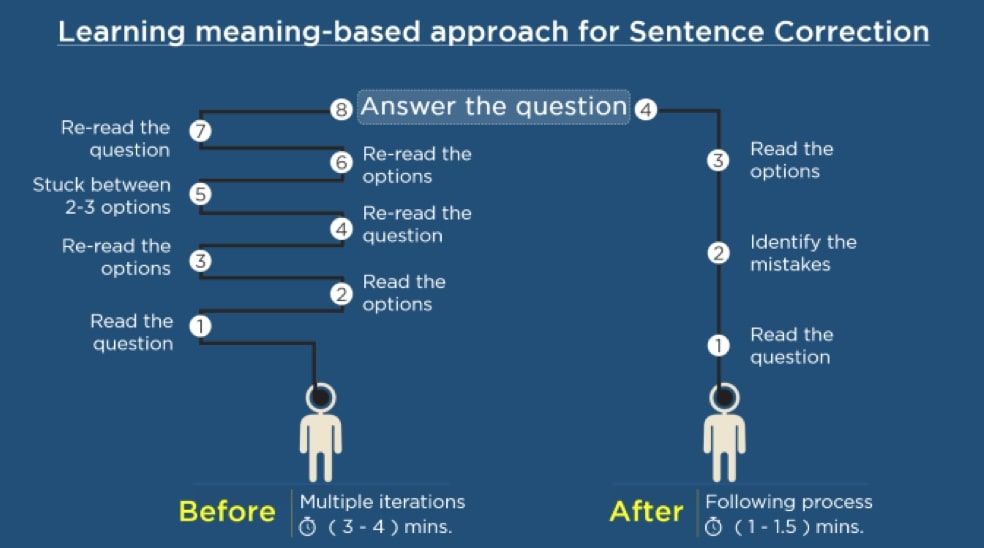
Therefore, he started with the Master Comprehension module to learn the components of a sentence and how to deconstruct a sentence. This module helped him to understand the meaning of a sentence in one read. This module also gave him a foundation to build his SC ability by learning the meaning-based approach. This approach helped him to identify the mistakes in the question before even reading the options. As he already knew the mistakes, the process of elimination became straight forward and it not only increased his accuracy but reduced the time per question to half.
Ram scored a 730 on the GMAT.
Let’s take another example to solidify what strategies work to ace GMAT SC.
Takeaways
To ace GMAT Sentence Correction
- you should focus on understanding the meaning of a sentence in one read. You can do that if you know how to deconstruct a sentence to understand its meaning. Therefore, going through the master comprehension module is essential before starting with SC preparation.
- Moreover, you should not read the options after reading the question. Your aim should be to identify the mistakes while reading the question itself. This process will eliminate the confusion that arises after reading the options without understanding the question.
These strategies will help you reduce the time required per question and increase your SC accuracy.
How to improve Critical Reasoning
Critical reasoning tests your ability to analyze an argument and draw a logical conclusion. You’ll be asked questions on the following topics:
- Inference
- Assumption
- Evaluate
- Strengthen and weaken
- Bold Face
- Paradox
So, what can you do to improve GMAT Critical reasoning? Let’s take the example of Arjun.
Arjun improved from V26 to V41 by improving his CR and scored 730 on the GMAT in his fourth attempt. He later got an admit from Oxford’s Saïd Business School and Indian School of Business.
Arjun scored a V41
Arjun used a brute-force approach to solving verbal questions before his 4th attempt in which he scored 730. By brute-force approach we mean, learning as many concepts and solving as many questions as possible without refining the concepts and application process.

Therefore, before attempting GMAT for the fourth time, Arjun changed his preparation strategy. This time he focused more on learning concepts and analyzing mistakes.
This strategy helped him improve his verbal ability, especially in Critical Reasoning.
He learned the pre-thinking approach to solving CR questions. He did the following after learning the pre-thinking approach:
- He started with easy questions (500-600 level questions) and practiced the pre-thinking approach with them.
- He reached a 90% accuracy level in easy questions of CR.
- After reaching this level, he started practicing difficult questions (700 level questions).
- He practiced CR questions in Scholaranium till he reached a 90% accuracy level.
Let us talk about Bhavya’s strategy for CR.
Bhavya’s CR strategy (V41)
She considered CR to be her strength. But still, she spent more than 3 minutes on each CR question. Her biggest challenge was to reduce her time per CR question. This is where the pre-thinking approach helped her the most.
She spent around a minute on understanding the question and then divided it into premise, conclusion, and understanding the assumption. This way she was able to improve her timing to 2 minutes per question.
Takeaways
- Understanding and applying the pre-thinking approach to solving CR questions is the key to acing this sub-section.
- Start applying the pre-thinking approach to easy and medium level questions first.
- Move on to the difficult questions only when you have reached a 90% accuracy level in easy and medium level questions.
- The pre-thinking approach will also help you reduce the average time per CR question even though there will be a learning curve initially.
How to improve Reading Comprehension
This is most overlooked sub-section of GMAT verbal owing to the less complex nature of this sub-section compared to SC and CR. However, after the change in GMAT format in April 2018, RC has become a more important sub-section. Therefore, you shouldn’t ignore the RC section and invest appropriate time to prepare it.
So, how to ace GMAT RC? Let’s learn from a few examples.
Anastasiia scored 740 with a V39 | Received admit from Columbia Business School
Even though she scored below V40, her story is worth mentioning because of her RC strategy. Initially, her reading comprehension ability was low (between 30% and 50%).
To tackle this weakness, she started reading from sources like The Economist. Then, she devised a 3-step strategy. She would
- Understand meaning
- Understand the examples used in the text
- Understand the sentence structure
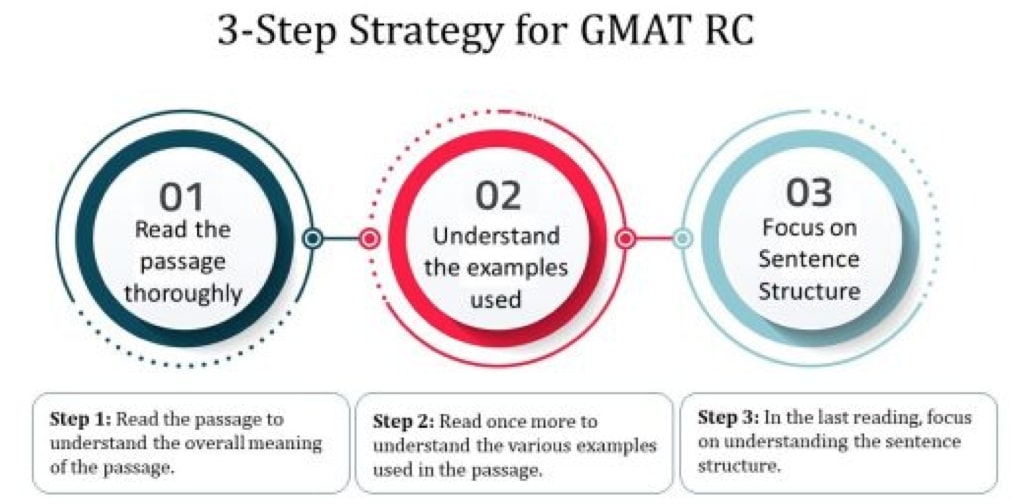
She would read the passage thoroughly first to understand the overall meaning. She would read once more to make sense of the examples mentioned in the passage and lastly, she would read to understand the sentence structure.
This approach required more time in reading the passage, but since she understood the information completely, she didn’t need to refer the text again. She was able to retain most of the information and answered the RC questions in one go.
Bruno’s V42 on the GMAT
Bruno scored a staggering V42. An achievement he credits to understanding the logic behind the questions. Since meaning-based approach and pre-thinking approach use logic to find solutions to questions, he performed well in both SC and CR.

His more significant challenge was the RC section. He had heard about a short-cut approach which tells you to read 20% of the passage and start answering questions. He tried this approach and failed. He realized it is just a waste of time since he had to revisit the passage again and again to answer the questions.
Therefore, he followed the e-GMAT’s approach to summarizing each paragraph. While reading a passage, he started summarizing each paragraph and noting down important takeaways. This information helped him answer the RC questions in one attempt without revisiting the passage.
Thus, he scored a 42 on his verbal section.
Bhavya’s RC strategy
Let me retake the example of Bhavya. She used to skip reading the whole passage and read only the first and last sentence of each paragraph. This strategy resulted in her revisiting the passage again and again and wasting valuable time. As she felt pressured due to lack of time, she would randomly mark the answers.
What she did was that instead of skipping, she started skimming the passage. She started to pay attention to the author’s tone and opinion. This strategy helped her understand the essence of the passage and separate important information from the unimportant. With this approach, she mastered reading comprehension.
Takeaways
To ace GMAT Reading Comprehension you should:
- Summarize and note down key takeaways of each paragraph
- Understand the meaning, the author’s tone and opinion, and make a note
- Separate essential information from the non-essential
- Lastly, read the questions and answer them
Test taking strategies to score V40+
Building your verbal ability is definitely going to help you score a V40+, but a planned effort during the test will fetch you those extra 2-3 points and boost your GMAT score.
You can learn a good test-taking strategy from Alok.
Alok scored V40 on the GMAT by employing a skipping strategy
Alok scored a 740 (Q50, V40) on his second attempt and improved from V33 in his first attempt. He said, “While my first attempt was all about studying, my second attempt was all about planning.” What he did was that he identified his weak topics from skills data in Scholaranium. These were the topics from which he was more likely to give incorrect answers. Moreover, he was comfortable in answering 37-38 questions with high accuracy. Based on this data he devised a skipping strategy.

A skipping strategy does not mean that you don’t answer questions (you are not allowed to leave a question unmarked in GMAT). Instead, you randomly mark the answer to the question you are not sure of so that you can devote time to questions where you are confident of answering correctly.
He skipped 4-5 questions including an entire RC passage on his actual GMAT and still managed to score a V40. This score clearly shows that it’s not accuracy that GMAT tests, rather GMAT tests your ability.
Therefore, devising a strategy based on your weaknesses is a key to scoring high on GMAT verbal.
GMAT Verbal tips from V40+ scorers
Above were some verbal tips from people who aced the GMAT, especially its verbal section. These tips on Sentence Correction, Critical Reasoning, and Reading Comprehension will definitely help you prepare well for the verbal section.

The only thing you have to keep in mind is that GMAT verbal tests your ability to think logically. Therefore, focus on understanding the meaning of a sentence in a timed manner. You can do it only if you can understand the meaning of a sentence in just one reading. What we’ll suggest you is go through the ‘master comprehension’ module, where you’ll learn how a sentence is constructed and deconstructed. Once you know the different components of a sentence, building your GMAT verbal ability will become easier.
The pre-thinking approach to solving CR questions is the most effective process, and you should stick to it. For RC passages the best strategy is to summarize each paragraph and note down key takeaways and tone of the author.
Lastly, remember to devise a skipping strategy for GMAT verbal section based on your weak topics. It is better to skip questions which you are unsure of answering correctly.














